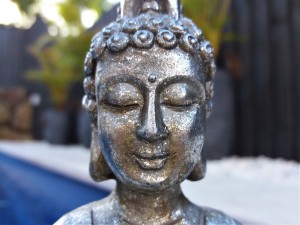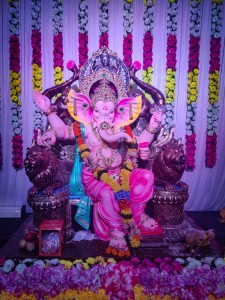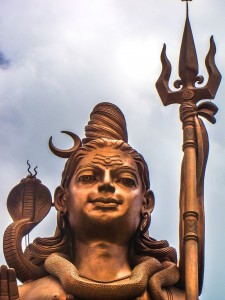
“Om is not just a sound or vibration. It is not just a symbol. It is the entire cosmos, whatever we can see, touch, hear and feel. Moreover, it is all that is within our perception and all that is beyond or perception. It is the core of our very existence.” – Amit Ray, Hindu Spiritual Master
Aaaaaauuuuuuummmmmm…. the most relaxing sound and mantra known to mankind. It is healing for us humans, physically and spiritually. It aid our meditations when unblocking our chakras or gaining wisdom from the Source or just simply bringing awareness to your spiritual practice. Om is God, it is divine energy, it is knowledge, it is truth, it is everything. It is a most sacred mantra that goes back a few millennia in human history. This article will cover all aspects of the Mantra, discussing the difference between each religion’s or each nations definition and meaning of the sound and symbol.
 What does OM mean?
What does OM mean?
OM, the main mantra of the Atman (Higher Self) is used to attune us to our true nature. The sound is comprised of three syllables; A, U, and M which each represent the divine energy of the shakti which is similar to the creator, the generator and the destroyer. or Brahma, Vishnu and Shiva. It also stands for the three Gunas (qualities) found in nature.
Ohm is used to invoke the vibration of the universe energy or divine energy. Om’s vibrational frequency is 432 Hz which is remarkably the very same frequency which is found in nature. This is an extremely healing frequency which can ease stress levels, lower your heart rate and spiritually unblock your throat chakra.
OM (pronounced Aum) is a sacred sound and an important symbol linked to spirituality found in Hinduism, Buddhism and Jainism. It is believed to be the sound of the universe and to have profound transformative power when chanted. It is the mantra of the Hindu gods Brahma, Vishnu, and Shiva. It is the combination of the Vedic Sanskrit letters aa, au, ma to create the Word of God. It is the primordial sound from which the universe was created. Aum is also representative of Ganesha, the Hindu elephant god, the remover of all obstacles.
Om has profound meanings in religious and spiritual circles, especially in India with Hinduism. It refers to the Atman which is your soul or your inner self, and Brahman which refers to the universe and everything in it, be it the tangible or intangible.
What does the Om symbol mean?
ॐ
The correct Sanskrit spelling is: AUM.
“A” represents the Waking State and creation.
“U” represents the Dream State and manifestation.
“M” represents the Deep Sleep State and destruction.
The silence at the end represents the void.
ॐ The lower left curve represents the conscious. The waking state of being.
ॐ The top left curve represents the unconscious state.
ॐ The lower right curve represents the dream state.
ॐ The semi circle at the top represents the Maya state which is the illusion. Representing the biggest obstacle to overcome in order to progress with spiritual development.
ॐ The dot at the top represents the absolute state which is the highest form of consciousness.
What does Om mean in yoga?
In yoga, chanting the sound Om three times at the beginning of a yoga class signifies the start of the yoga session. Similarly, chanting Om three times at the end signifies the end of the session. When chanted with a group it creates unity and a sense of community. In doing so one can create a sense of harmony with the group and feel one with the universe.
Om history in yoga
 Yoga has been in India for thousands of years, suspected to have originated in the Indus Valley civilization around 3000BCE. One of the most well known Sanskrit works on yoga is the Yoga Sutra, a text on yoga theory and practice, believed to have been written by a sage by the name of Patanjali around 500BCE – 400CE. This text is one of the most important texts in the Hindu religion. One of the most important mantra’s used in yoga is the Omkar Mantra. Many yogi’s chant the Omkar while focusing on the dot of the Om, which is called a Bindu. In doing so yogi’s are able to expel all bad intentions and allow themselves to fulfil all desires for a healthy body, mind and soul. The sound vibration created from doing this brings the practitioner closer to God or divine energy and be able to heal one’s own nervous system.
Yoga has been in India for thousands of years, suspected to have originated in the Indus Valley civilization around 3000BCE. One of the most well known Sanskrit works on yoga is the Yoga Sutra, a text on yoga theory and practice, believed to have been written by a sage by the name of Patanjali around 500BCE – 400CE. This text is one of the most important texts in the Hindu religion. One of the most important mantra’s used in yoga is the Omkar Mantra. Many yogi’s chant the Omkar while focusing on the dot of the Om, which is called a Bindu. In doing so yogi’s are able to expel all bad intentions and allow themselves to fulfil all desires for a healthy body, mind and soul. The sound vibration created from doing this brings the practitioner closer to God or divine energy and be able to heal one’s own nervous system.
What does om mean in meditation?
Chanting Om in meditation serves as a tool in order to relieve the body and mind of stress and anger. It helps to submerge you into a deep meditative state so you can better connect to the divine energy of the universe or your self. Practicing this can set you on a path of mindfulness, which is being aware of your surroundings and being ever present in the current moment.
Om history in meditation
 Om’s history in meditation goes all the way back to the texts of the Upanishads, specifically the Bhagavad Gita, labeled as Pranava Yoga which is the meditation on the sacred mantra Om. Pranava Yoga is also mentioned in the Yoga Sutra by Patanjali. By focusing the mind on the mantra Om one is able to free themselves from suffering and any limitations. Om meditation is apart of the ancient and recently revived teachings of Kriya yoga. Kriya Yoga meditation involves breathing in and out while chanting Om in a specific mudra. A mudra is holding of a certain symbolic gesture often focusing on the hands and fingers but the whole body could be used as well. Certain mudra hand gestures focus on different chakras throughout the body.
Om’s history in meditation goes all the way back to the texts of the Upanishads, specifically the Bhagavad Gita, labeled as Pranava Yoga which is the meditation on the sacred mantra Om. Pranava Yoga is also mentioned in the Yoga Sutra by Patanjali. By focusing the mind on the mantra Om one is able to free themselves from suffering and any limitations. Om meditation is apart of the ancient and recently revived teachings of Kriya yoga. Kriya Yoga meditation involves breathing in and out while chanting Om in a specific mudra. A mudra is holding of a certain symbolic gesture often focusing on the hands and fingers but the whole body could be used as well. Certain mudra hand gestures focus on different chakras throughout the body.
What does om mean in Hindi (Hindi)?
In Hindi it literally translates into the number four. In Hinduism om is an extremely sacred syllable symbol and mantra of Brahman. Om refers to the Atman which is oneself, ones soul and inner being and Brahman which is everything, the universe and everything in it. In chanting the mantra Om one can create a connection with oneself (Atman) and the universe (Brahman).
Om history in Hinduism
 Om was first mentioned in the Upanishads, which are late Vedic Sanskrit religious and philosophical texts still revered in Hinduism today. The Upanishads are the latest parts of the Vedas which are the oldest Hindu texts dating back to Ancient India in about 1500BC – 1200BC. In the Upanishads Om is described with having many different connotations. Om is the sacred sound, the Yes! The Udgitha (the sound of the universe), the ultimate reality, the finest essence, the truth, the cause of the Universe, Brahman, Atman, self-knowledge. Om started to be used as a standard utterance at the start of any mantra or citation taken from the sacred Vedas. Today it is still common practice in Hinduism to begin and end major incantations and ceremonies with the sound Om.
Om was first mentioned in the Upanishads, which are late Vedic Sanskrit religious and philosophical texts still revered in Hinduism today. The Upanishads are the latest parts of the Vedas which are the oldest Hindu texts dating back to Ancient India in about 1500BC – 1200BC. In the Upanishads Om is described with having many different connotations. Om is the sacred sound, the Yes! The Udgitha (the sound of the universe), the ultimate reality, the finest essence, the truth, the cause of the Universe, Brahman, Atman, self-knowledge. Om started to be used as a standard utterance at the start of any mantra or citation taken from the sacred Vedas. Today it is still common practice in Hinduism to begin and end major incantations and ceremonies with the sound Om.
What does om mean in Buddhism?
Om/aum in Buddhism is very similar in meaning to the Hindu version. It translates into the totality of sound, existence and consciousness in Buddhism.
Om history in Buddhism
 The history of Om in Buddhism reached into later schools of Buddhism, such as the Tibetan Buddhists, influenced by the Hindu religion. Om is placed at the beginning of mantras and dharanis (Buddhist chant, incantation, or recitation, usually a mantra consisting of Sanskrit or Pali phrases). AUM is a very holy and sacred word for Esoteric Buddhists. Om is still used today between Esoteric Buddhists in many mantras representing for them wholeness, perfection and the infinite. One of the most famous Buddhist mantras including Om is “Om Mani Padme Hum” a Sanskrit mantra which is associated with the four armed Shadakshari form of Avalokiteshvara or Padmapani, a Bodhisattva who embodies the compassion of all Buddhas. This phrase was first cited in the Mahāyāna Kāraṇḍavyūha a 4th to 5th century Mantrayāna sūtra which promotes the virtues and powers of Avalokiteshvara/Padmapani.
The history of Om in Buddhism reached into later schools of Buddhism, such as the Tibetan Buddhists, influenced by the Hindu religion. Om is placed at the beginning of mantras and dharanis (Buddhist chant, incantation, or recitation, usually a mantra consisting of Sanskrit or Pali phrases). AUM is a very holy and sacred word for Esoteric Buddhists. Om is still used today between Esoteric Buddhists in many mantras representing for them wholeness, perfection and the infinite. One of the most famous Buddhist mantras including Om is “Om Mani Padme Hum” a Sanskrit mantra which is associated with the four armed Shadakshari form of Avalokiteshvara or Padmapani, a Bodhisattva who embodies the compassion of all Buddhas. This phrase was first cited in the Mahāyāna Kāraṇḍavyūha a 4th to 5th century Mantrayāna sūtra which promotes the virtues and powers of Avalokiteshvara/Padmapani.
Om mantras: our favourites
Shanti Mantra: Om śāntiḥ śāntiḥ śāntiḥ ( A-U-M Shanti Shanti Shanti)
Meaning: Om Peace Peace Peace
Invocation to Ganesha: Om gam ganapataye namah / vakra-tunda maha-kaya surya-koti-sama-prabha / nirvighnam kuru me deva sarva-karyeshu sarva-da
Meaning: Salutations to Ganesha. O Ganesha, god with a curved trunk, of great stature,
Whose brilliance is equal to ten million suns. Grant me freedom from obstacles, In all things, at all times. Mangala Mantra: svasti prajabhyah paripalayantam nyayena margena mahim mahishah / gobrahmanebhyah shubham astu nityam lokah samastah sukhino bhavantu
Mangala Mantra: svasti prajabhyah paripalayantam nyayena margena mahim mahishah / gobrahmanebhyah shubham astu nityam lokah samastah sukhino bhavantu
Meaning: May the rulers of the earth protect the well-being of the people, With justice, by means of the right path. May there always be good fortune for all living beings. May all the inhabitants of the world be full of happiness.
The Mantra: A chant from the Upanishads: Om saha nav avatu / saha nau bhunaktu / saha viryam karavavahai / tejasvi navadhitam astu ma vidvishavahai / Om shanti shanti shanti
Meaning: May we together be protected, May we together be nourished. May we work together with vigor, May our study be illuminating. May we be free from discord.
Om Peace, Peace, Peace!
The mantra: A chant from the Brihadaranyaka Upanishad
asato ma sad gamaya / tamaso ma jyotir gamaya / mrityor ma amritam gamaya
Meaning: From the unreal to the Real, lead me. From darkness to Light, lead me. From death to Immortality, lead me.
Key takeaways
Now that we have gone through the history and meaning of Om we can see the significance that the sacred syllable Om has on millions of people, and multiple religions. It is not religion exclusive and is able to be learnt by any and all. It has proven to have grand effects on the mind and the body when practiced correctly. Surviving the trail of time and spreading out of India and into the western and eastern societies. The sacred mantra of Om has proven to be an integral part of millions of peoples lives and well being and will continue to spread it’s roots in peoples lives for many years to come.
FAQs
How do you chant om correctly?
You start off by making an AH sound, so that the back of the tongue gets dropped low in the mouth that gives us a loft resonance. Then the OOH sound so that it brings the back of the tongue high in the mouth ensuring a depth of sound. Finally ending it off with MM sound creating an end to the Mantra. So we have a clear beginning, middle and end. Then there is the silence that follows between the next Om. Aaa—Uoo—Mmm, silence, repeat.
What other frequencies have power?
The solfeggio frequencies (528hz) are especially powerful and can even repair and contribute to dna activation.
Why chant om 3 times?
Chanting the Om mantra 3 times has purpose in that it symbolizes the three worlds of the soul. It is representative of the past, present and future.
 Written by:
Written by:
Jade Small
 What does OM mean?
What does OM mean?





Leave a Reply
You must be logged in to post a comment.